TEAM DEVELOPMENT
Innovative organisations invest in teams. Good team dynamics and collaboration are key to achieving sustainable results. These teams know themselves and each other, value each other's differences and make the best use of each other's qualities for the benefit of the whole organisation.
"A team that is well connected in relationship and task can handle any difficult situation".
Wirework develops, facilitates and consults:
- Team development programmes
- Team coaching
- Workshops (collaboration and effectiveness)
METHODS AND TOOLS USED
The Rationale for Change Method
Discussing the rationale for change up front can help you create a shared perspective. It helps to articulate what isn't visible, provides direction and guidance, and determines what change interventions are needed to achieve the desired outcome. Why - the intention to change | What? - the change idea | How? - the change process | Who? - The people involved.
Insights Discovery®
Insights Discovery is a non-judgmental psychometric tool based on the psychology of Carl Jung. The model is based on the uniqueness of the individual and is designed to help people understand themselves, understand others and make the most of the relationships that affect them in the workplace.
Insights Discovery Full Circle®
Insights Discovery Full Circle is a 360 feedback tool that adds an extra dimension to awareness. Compiled from the feedback of a group of self-selected respondents, the profile gives participants a fresh perspective on their impact on others. Discussing mutual perceptions creates deeper personal growth for the participant and improves the relationship with the respondent. This profile is designed to complement the Insights Discovery Profile, which is based solely on self-perception.
Insights Discovery Team Effectiveness®
The Team Effectiveness Model maps the effectiveness of teams by 'measuring and discussing' critical success factors. The model is based on 4 pillars: focus, flow, climate, process, and uses a value-free colour language. Team members discuss which elements they are most/least effective in, express their ambitions in relation to the strategy and explore which KPIs can drive the desired effectiveness. By repeating the exercise periodically, a team's development can be monitored and adjusted if necessary.


Team development using Lencioni's pyramid
This five-level model is a proven method for improving team collaboration. It consists of the components of trust, conflict, commitment, accountability and results, and focuses on working together at individual and group levels. Only when teams recognise that they are different as individuals can they really work well together. By accepting the differences between them, they overcome team frustrations.
“If you can get all the people in your organisation on the same page, you can dominate any industry, in any market, against any competition, at any time” - Patrick Lencioni.

Team development using the Tuckman model
When people work together within an organisation, it often takes time for them to function as a team. The five stages of team development within the Tuckman model provide an insight into the development of a team over time. According to Bruce Tuckman, the stages (Forming, Storming, Norming, Performing, Mourning) must be experienced in a fixed order. Only then can a team function optimally. Until a team has gone through shared conflicts and established behavioural norms, it will never perform well.
Team coaching with the growth mindset model
The concept of a growth mindset, coined by Stanford psychologist Carol Dweck, is the belief that a person's skills and talents can improve over time. People with a growth mindset believe that the learning process never ends. If they are not good at something at first, they will improve with hard work and an open mind. This mindset helps to bring team members closer together, have positive conversations and be open to opportunities and innovation.
© 2023 WIREWORK ALL RIGHTS RESERVED


